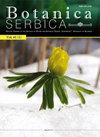Expression of heavy metal ATPases (HMA1 and HMA3) in Brassica nigra and B. juncea grown at different Cu levels
IF 1.1
4区 生物学
Q4 PLANT SCIENCES
引用次数: 0
Abstract
Metal pollution is a major environmental problem which affects agriculture and human health. Turkey has significant Cu mining areas in Diyarbak?r and its surrounding areas (Southeast Anatolia). Several crop plants cultivated in these areas are irrigated with water from the Tigris, and most agricultural lands are contaminated with Cu. Brassica nigra and B. juncea are well-known metal accumulator plant species which can hyperaccumulate metals, including copper, in their shoots. The purpose of this study is to evaluate their potential for the phytoremediation of Cu from these contaminated areas as an environmentally friendly and cost-effective means of reducing Cu-contamination. In this research, B. nigra and B. juncea plants were grown in soil at different Cu concentrations (0 to 1000 ?M) and showed no toxicity symptoms while accumulating a significant amount of metal in their leaves. In the leaves of both species, the Cu content increased significantly with the increase in the Cu level in the media. HMA1 (Heavy Metal ATPase 1) in the leaves of both plant species gradually increased with increased Cu levels until 50 ?M, then its expression slowly decreased with the further increase in Cu levels. The expression of HMA3 also increased with an increase in Cu in the leaves of both plant species. However, its expression pattern differed from that of HMA1. Our data showed that an increase in Cu levels in the leaves triggers the expression of both genes, suggesting that they play an active role in Cu detoxification. We propose that these plant species could be used for the decontamination of Cu from polluted soils. These data also indicate that Cu accumulation and tolerance in both plant species is probably a multi-genetic response, possibly involving several other transporter genes in the stress signal pathway. Hence, we also explored the expression of the other metal transporters, such as other HMAs (HMAs 5-8), Nramps (e.g., Nramp3), COPT proteins, and some Cu chaperons in these plant species.重金属atp酶(HMA1和HMA3)在不同Cu水平下生长的芸苔和芥菜中的表达
金属污染是影响农业和人类健康的重大环境问题。土耳其在迪亚巴克拥有重要的铜矿区。r及其周边地区(安纳托利亚东南部)。在这些地区种植的一些农作物用底格里斯河的水灌溉,大多数农田都被铜污染了。黑芸苔(Brassica nigra)和芥菜(B. juncea)是众所周知的金属积累植物,它们可以在其茎部过度积累金属,包括铜。本研究的目的是评估它们作为一种环境友好和经济有效的减少Cu污染的方法在这些污染地区的植物修复潜力。在不同Cu浓度(0 ~ 1000 μ M)的土壤中,黑穗草和芥菜植株均未表现出中毒症状,但叶片中积累了大量的金属。两种植物叶片中Cu含量均随培养基中Cu水平的增加而显著增加。两种植物叶片中HMA1 (Heavy Metal ATPase 1)的表达量在50 μ M前随Cu水平的升高而逐渐升高,而后随Cu水平的进一步升高而缓慢下降。两种植物叶片中HMA3的表达也随着Cu含量的增加而增加。但其表达模式与HMA1不同。我们的数据表明,叶片中Cu水平的增加触发了这两个基因的表达,表明它们在Cu解毒中发挥积极作用。我们建议这些植物可以用于污染土壤中的铜的去污。这些数据还表明,两种植物的Cu积累和耐受性可能是一个多遗传反应,可能涉及胁迫信号通路中的其他转运基因。因此,我们也探索了其他金属转运体的表达,如其他HMAs (HMAs 5-8)、nramp(如Nramp3)、COPT蛋白和一些Cu伴侣蛋白在这些植物物种中的表达。
本文章由计算机程序翻译,如有差异,请以英文原文为准。
求助全文
约1分钟内获得全文
求助全文
来源期刊

Botanica Serbica
Agricultural and Biological Sciences-Plant Science
CiteScore
1.40
自引率
12.50%
发文量
17
审稿时长
34 weeks
期刊介绍:
Botanica Serbica publishes original research papers on all aspects of plant, fungal and microbial biology research including the disciplines of microbiology, mycology, lichenology, bryology, flora, vegetation, biogeography, systematics, taxonomy, plant biotechnology, plant cell biology, plant ecology, environmental plant biology, forestry, genomics, horticulture, limnology, metabolomics, molecular biology, proteomics, virology, plant conservation and protection, and wildlife and ecosystem management.
 求助内容:
求助内容: 应助结果提醒方式:
应助结果提醒方式:


